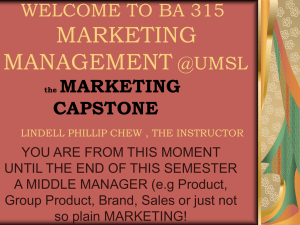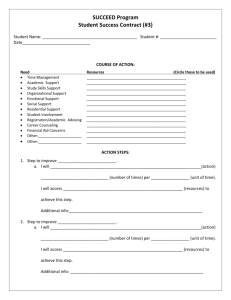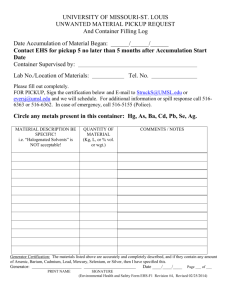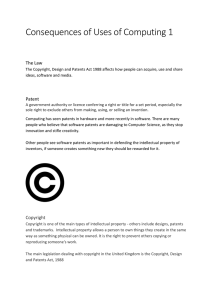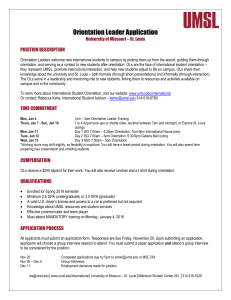Korean Academy of Science and Technology November 20, 2003
advertisement
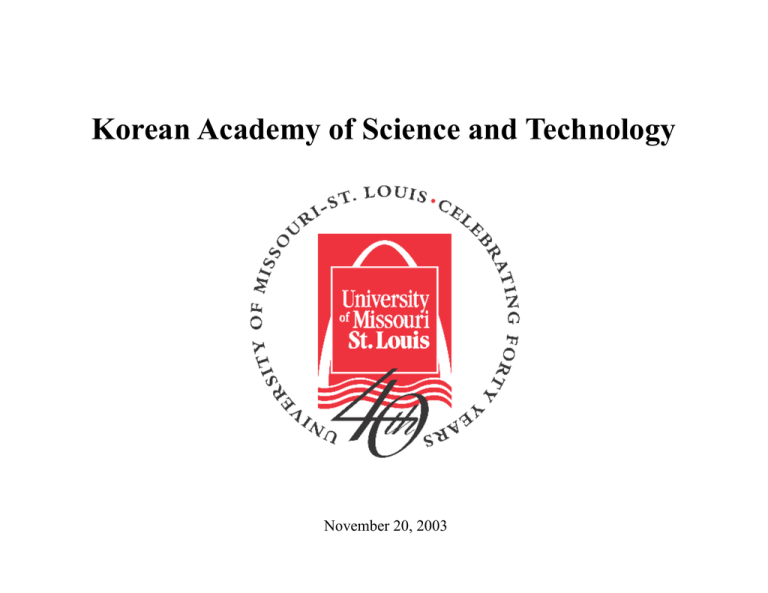
Korean Academy of Science and Technology November 20, 2003 Presentation by Thomas F. George, Ph.D. Chancellor and Professor of Chemistry & Physics University of Missouri-St. Louis I. Evolution of Academic Philosophy: From Basic Research to Technology Transfer Definition: Technology transfer is the process of taking an invention from its inception in a laboratory to a commercialized product. Obstacles to Effective Technology Transfer: In the traditional view, overt commercialization is in contradiction to the pure goal of scientific enquiry. Private universities with large endowments have been concerned that engaging in commercialization may subject them to lawsuits. II. Stages of Technology Transfer: From Research Support to Economic Growth Federal Corporate Startups State Research Support More in Tax Revenues Inventions Disclosure Endowment Patents Licenses New Products Higher Standard of living Economic Growth New Jobs Measuring the Impact of Technology Transfer in the Production Function What Does this Production Function Tell Us About Technology Transfer? Investment in R&D is a necessary but not a sufficient condition for economic growth. Productivity gains only result from the natural diffusion of innovation to the marketplace (technology transfer). Determinants of Successful Technology Transfer Intellectual property rights must be provided to the research grantee regardless of the source of funding (e.g., federal, state, …) - Role of regulation Professional management of property rights and startup companies Competitive venture capital market Efficient capital market for initial public offering Who Should Own the Initial Public Offering? In the United States, the first patent was issued in 1790. Less than 100,000 patents were issued in the first 200 years. Until 1980, the federal government retained most of the patents on discoveries it had funded. By 1980, the federal government had licensed only 4% of the 28,000 patents it owned. Up to this point, technology transfer was slow. Passage of the Bayh-Dole Act in 1980 allowed universities and other non-profit entities, which had received government research grants and contracts, to retain the title to their inventions. Implications of the Bayh-Dole Act The pace of new patents issued has accelerated since 1980. Between 1980 and 2001, the number of patents issued each year almost tripled (Figure 1). In 2001, the U.S. Patent Office issued 184,000 patents. Innovations in the U.S. may be patented in other countries. Similarly, foreign countries may patent in the U.S. In 2001, 46% of all patents in the U.S. were issued to foreign individuals and entities. Figure 1 U.S. Patent Statistics 1980 – 2001 Universities and Technology Transfer The share of university-owned patents increased from less than 1% of total patents issued in 1980 to about 5% in 2001 (Figure 2). According to a survey of 200 U.S. and Canadian universities, royalties from licensed products from technology developed by these universities increased to $845 million in 2001, up 12% from the previous year. 500 new companies based on academic research were formed in 2001, of which 84% were established in the state or province of the academic institution where the technology was developed. Since 1980, almost 4,000 new businesses have been created, with 2,200 still in operation as of 2001. Universities now hold equity positions in 70% of their startups. Figure 2 Utility Patents Assigned to U.S. Universities University Patents as % of U.S. Corporate-Owned Utility Importance of Professional Management in Technology Transfer While scientists with important discoveries are the intellectual backbone of the startups, generally they are not equipped with sufficient expertise to run a startup. Tasks in running a startup company: – – – – – – – – Writing business plans Negotiating with suppliers of capital (e.g., angel and venture capital) Establishing contracts to mitigate potential incentive conflicts Recruiting human capital Conducting market research Performing clinical trials Seeking regulatory approval Launching products Solution: Universities must train managers with expertise in running startup companies (i.e., MBAs with emphasis in tech transfer and commercialization). A Competitive Venture Capital Market Attributes of a successful venture capital firm: – Expertise in technologies used by startups – Willingness to take the higher risk imbedded in startups in exchange for a residual claim – Ability to mitigate incentive problems between entrepreneurs and suppliers of capital – Geographic diversification to reduce the risk of regional economic fluctuations – The inherent discipline in a venture capital firm with finite life cycle (i.e., 10 years), which dictates a clear investment exit plan within a relatively short period of time Venture Capital, IPO & Efficient Capital Market Some sectors are more volatile then others. For example, from 2000 through 2002, information technology sector funding dropped by 80%. During the same period, the healthcare sector saw only 45% drop in investment (Figure 3). Successful exit for a venture capital firm and access to more capital for a startup often depend on favorable conditions in the stock market and feasibility of an IPO (Figure 4). Figure 3 Equity Financings for US Venture-Backed Companies, by Industry Group Amount Invested Figure 4 IPO & NASDAQ Composite Statistics 1999 – 2002 III. University of Missouri-St. Louis Experience UMSL is the metropolitan public research university in St. Louis. It strives to strengthen its educational programs at all levels, enhance the research capacities of its faculty and students, and serve the region’s needs through research and technology transfer, cooperative and educational outreach programs and work force development. Excerpted from “UMSL Strategic Plan, FY203-2007 UMSL Research Profile UMSL Metropolitan Research Business Criminology Education Continuing Education and Outreach Psychology Public Policy Research Center Social Work Life Sciences UMSL Academic Units Involved in Plant & Life Sciences Research Biology Chemistry and Biochemistry Physics and Astronomy Nursing Optometry UMSL Partnerships in Life Sciences Donald Danforth Plant Science Center Center for Emerging Technologies St. Louis Technopolis (CORTEX) Missouri Botanical Garden St. Louis Zoo How to Expand UMSL’s Research Capacity Increase the number of tenured/tenure-track faculty Renovate Benton/Stadler Halls (sciences) Build multi-purpose health sciences complex Develop business, technology & research park UMSL is Founding Member of Research Alliance of Missouri IV. Expected Outcomes Efficient and productive research with measurable outcomes – Double research funding within five years – Increase the number of successful technology transfers from one a year to three a year within five years – Work toward establishing an IT incubator facility that will house both university startups and others. Plan to have three university startups within five years. – Measure and report new job creation through various activities. For example, the UMSL partnership in the Center of Research, Technology and Entrepreneurial Expertise is expected to generate 4,000 new jobs within five years.
